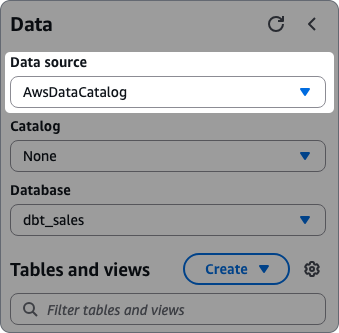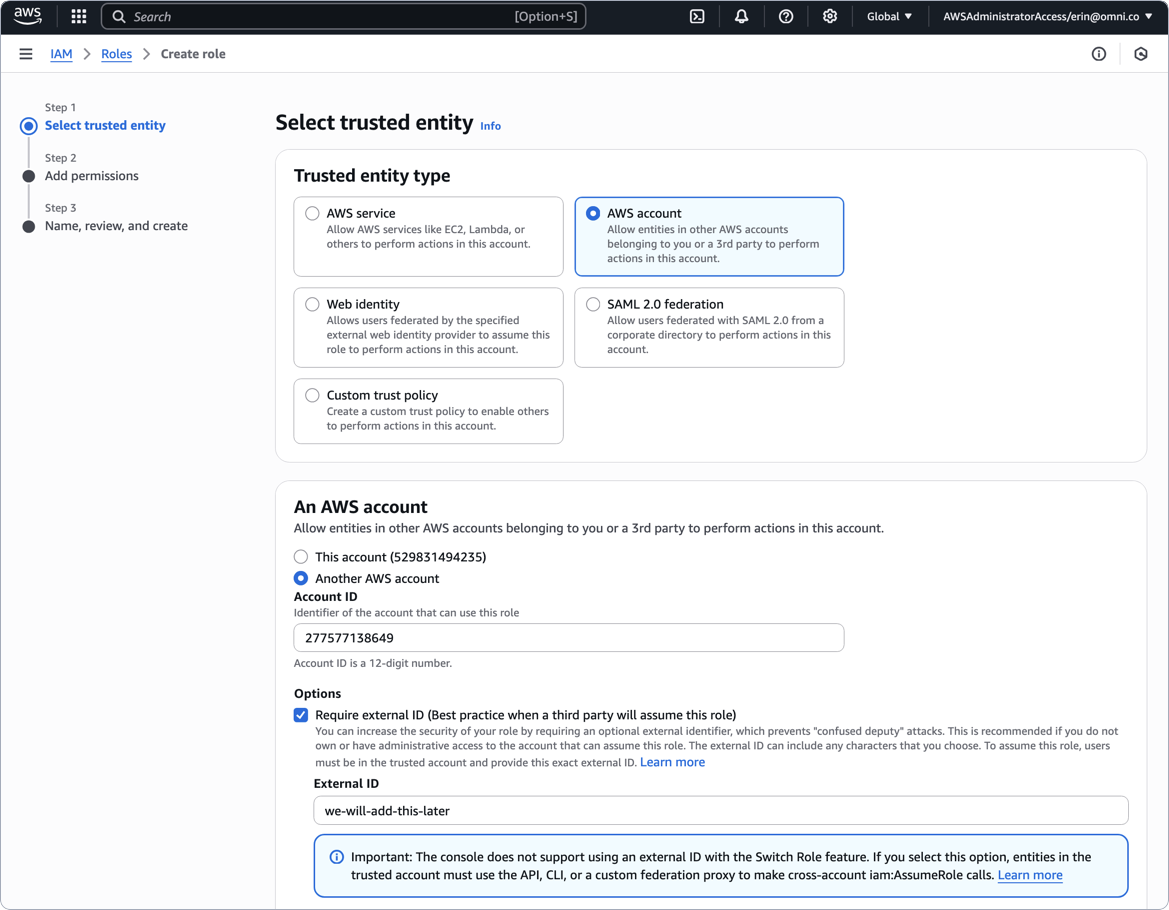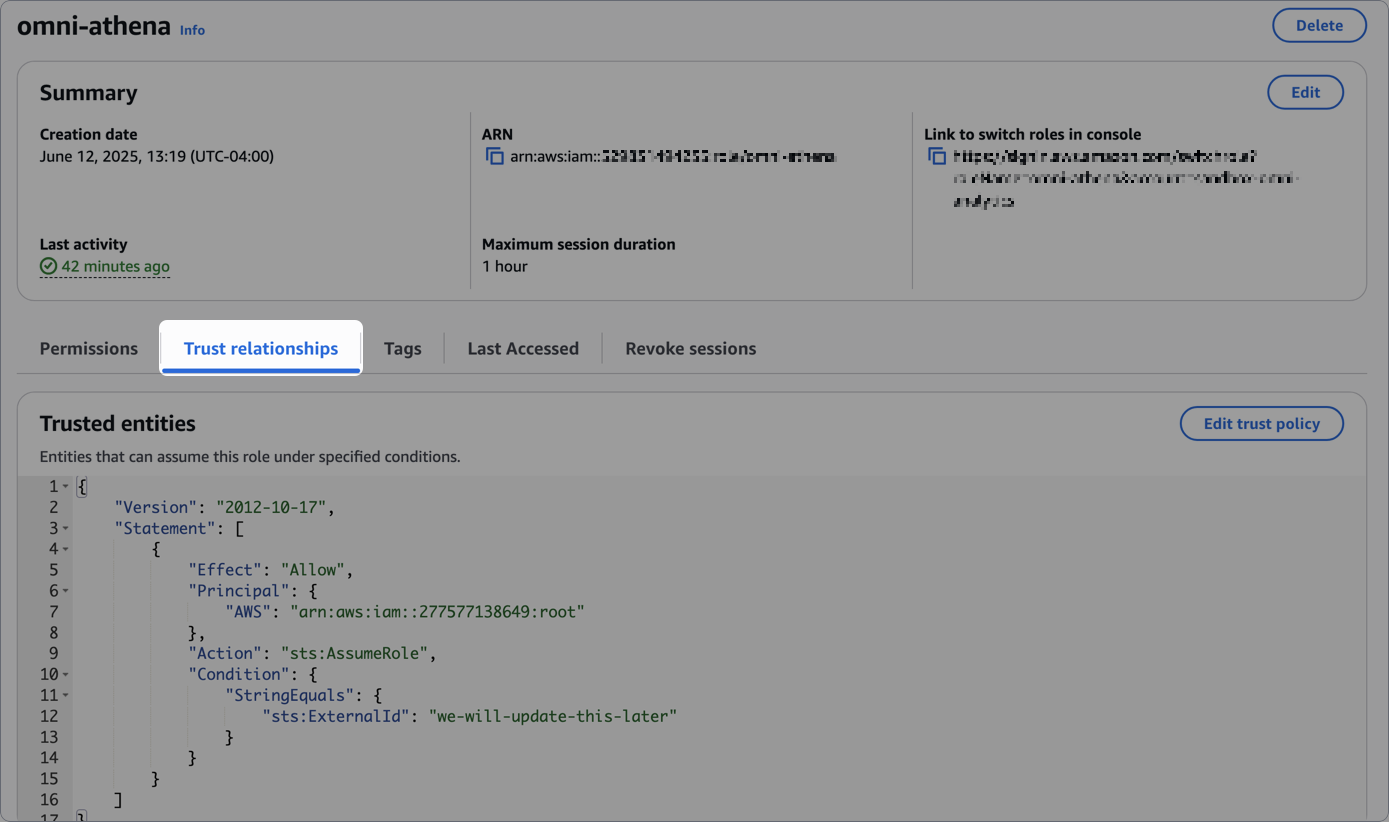Amazon Athena
In this guide, you'll learn how to connect your Amazon Athena database to Omni.
Omni's Athena integration supports two types of authentication:
- Access key - Uses an IAM user to authenticate to Amazon Web Services (AWS) by providing Omni with the user's Access key ID and Secret access key
- Cross-account role - Enables Omni services to assume an IAM role in your account
Requirements
To follow the steps in this guide, you'll need:
- An existing Athena database. Additionally, this database should have an S3 bucket configured to store query results. Refer to the AWS documentation to get started.
- Omni Organization Admin permissions. This is required to create the Athena connection in Omni.
Depending on the type of authentication you want to use, you'll also need permissions in AWS that:
- Allow you to create access keys
- Allow you to create IAM permission policies and roles
Option 1: Access key authentication
To use this method of authentication, you'll need to create an access key in the AWS console and then add it to the Athena configuration in Omni.
1. Create the access key in AWS
To complete this step, you need permissions in AWS that allow you to create access keys.
In the AWS console, follow these instructions to create an access key. Note: The key will only display once after it's created - make sure to copy it immediately.
2. Create the connection in Omni
-
In Omni, click Settings > Connections.
-
Click Add connection.
-
Click Amazon Athena.
- Fill in the fields as follows:
-
Display name - Required. Enter a name for the connection, which will display in the connections list in Omni.
-
S3 Output Bucket - Required. Enter the name of the Amazon S3 bucket in your account used to store query results for the Athena database. For example,
s3://blobs-r-us-ecommerce/ -
Data Catalog - Required. Enter the name of the data catalog you want to connect to in lowercase. In the Athena Query editor, this is the Data source value:

In this example, you'd enter
awsdatacataloginto the Data catalog field in Omni. -
Include Other Data Catalogs - Enter the names of other data catalogs you want to generate models for, in the format of
catalog1,catalog2. -
Include schemas - To only include specific schemas, enter the names of the schemas as a comma-separated list. Leaving this field blank will allow Omni to access all schemas in the database.
-
Default schema - Required. Enter the name of the default schema for the database.
-
Authentication Type - Select AWS Access Key.
-
AWS Access Key ID - Required. Enter the ID of the access key you created in Step 1.
-
AWS Secret Access Key - Enter the secret access key of the access key you created in Step 1.
-
Database timezone - Required. Select the timezone used by the database.
-
Query timezone - Required. If specified, data will be converted from the Database timezone to this timezone when querying. Refer to the Converting timezone data guide for more information.
-
Allow User-Specific Timezones - Check this option to allow individual users' Query timezone settings to be used as the query timezone for the connection.
-
Region - Enter the AWS region the database is in. Defaults to
us-east-1. -
Base Access - Elect the minimum level of access users should have for models in the connection.
-
- When finished, click Create connection.
Option 2: Cross-account role authentication
Cross-account role authentication allows you to specify an IAM role for Omni to assume when connecting to Athena.
1. Open the Athena setup page in Omni
-
In Omni, click Settings > Connections.
-
Click Add connection.
-
Click Amazon Athena.
Leave this page open for now - you'll need it in the next step.
2. Create an AWS IAM role
To complete this step, you need permissions in AWS that allow you to create IAM policies and roles.
2.1. Create an IAM policy
In this step, you'll create an IAM policy that grants the required permissions to the IAM role Omni will assume.
-
Sign into your AWS console.
-
Navigate to IAM, then click Roles in the left navigation.
-
On the page that displays, click Create policy.
-
In the Policy editor section, click the toggle to JSON:

-
In the policy editor, paste the following policy. Replace
<NAME-OF-ATHENA-QUERY-RESULTS-BUCKET>with the name of the S3 bucket used to store Athena query results:{
"Version": "2012-10-17",
"Statement": [
{
"Sid": "BasePermissionsForAllS3Buckets",
"Effect": "Allow",
"Action": [
"s3:ListAllMyBuckets",
"s3:ListBucket",
"s3:GetBucketLocation"
],
"Resource": "*"
},
{
"Sid": "BaseAndQueryPermissionsForQueryResultBucket",
"Effect": "Allow",
"Action": [
"s3:GetObject",
"s3:ListBucket",
"s3:GetBucketLocation",
"s3:ListBucket",
"s3:ListBucketMultipartUploads",
"s3:ListMultipartUploadParts",
"s3:AbortMultipartUpload",
"s3:PutObject"
],
"Resource": [
"arn:aws:s3:::<NAME-OF-ATHENA-QUERY-RESULTS-BUCKET>",
"arn:aws:s3:::*/*"
]
},
{
"Sid": "GluePermissions",
"Effect": "Allow",
"Action": [
"glue:GetTables",
"glue:GetDatabases",
"glue:GetDatabase",
"glue:GetTable"
],
"Resource": "*"
},
{
"Sid": "AthenaPermissions",
"Effect": "Allow",
"Action": [
"athena:StartQueryExecution",
"athena:GetQueryResults",
"athena:GetQueryResultsStream",
"athena:ListDatabases",
"athena:GetQueryExecution",
"athena:ListTableMetadata"
],
"Resource": "*"
}
]
}Note: If your data is stored in a separate bucket than the query results, you'll need to add an additional permissions block to the policy:
{
"Sid": "S3AccessForDataBuckets",
"Effect": "Allow",
"Action": [
"s3:GetObject",
"s3:ListBucket"
],
"Resource": [
"arn:aws:s3:::<NAME-OF-BUCKET-CONTAINING-DATA>",
"arn:aws:s3:::<NAME-OF-BUCKET-CONTAINING-DATA>/*"
]
} -
Click Next.
-
On the Policy details page, enter a name and description for the policy.
-
When finished, click Create policy.
2.2. Create the IAM role
In this step, you'll create the IAM role and attach the permissions policy you created in the last step to it.
-
You should still be in the IAM section of the AWS console. If not, navigate there.
-
Click Roles in the left navigation.
-
On the page that displays, click Create role.
-
Define the trusted entity for the role as follows:
- Trusted entity type - Select AWS account
- In An AWS account, click Another AWS account
- Account ID field - Paste the AWS Account ID value from the Omni setup page
- In Options, check Require external ID
- External ID - Enter a placeholder value - we used
we-will-add-this-laterin the below image. You will update this after you save the connection in Omni!
At this point, the page should look like this:

When finished, click Next.
-
On the Add permissions page, locate and select the policy you created in the previous section.
-
Click Next.
-
In the Role details section, enter a name for the role.
-
Review the selections and click Create role when finished.
After the role is created, open its details page in AWS and locate the ARN near the top of the page:

Leave this page open - you'll need it to complete the setup.
3. Create the connection in Omni
Navigate back to the Athena setup page in Omni and fill in the fields as follows:
-
Display name - Required. Enter a name for the connection, which will display in the connections list in Omni.
-
S3 Output Bucket - Required. Enter the name of the Amazon S3 bucket in your account used to store query results for the Athena database. For example,
s3://blobs-r-us-ecommerce/ -
Data Catalog - Required. Enter the name of the data catalog you want to connect to in lowercase. In the Athena Query editor, this is the Data source value:

In this example, you'd enter
awsdatacataloginto the Data catalog field in Omni. -
Include Other Data Catalogs - Enter the names of other data catalogs you want to generate models for, in the format of
catalog1,catalog2. -
Include schemas - To only include specific schemas, enter the names of the schemas as a comma-separated list. Leaving this field blank will allow Omni to access all schemas in the database.
-
Default schema - Required. Enter the name of the default schema for the database.
-
Authentication Type - Select AWS Cross Account Role.
-
AWS Role ARN - Paste the role ARN you retrieved in Step 2.2.
-
Database timezone - Required. Select the timezone used by the database.
-
Query timezone - Required. If specified, data will be converted from the Database timezone to this timezone when querying. Refer to the Converting timezone data guide for more information.
-
Allow User-Specific Timezones - Check this option to allow individual users' Query timezone settings to be used as the query timezone for the connection.
-
Region - Enter the AWS region the database is in. Defaults to
us-east-1. -
Base Access - Elect the minimum level of access users should have for models in the connection.
When finished, click Create connection.
Note: After you save the connection, you'll likely see an error similar to System message: AWS Role must be configured to check for an External ID - don't worry! You're going to address this in the next step.
4. Add the Omni external ID to the IAM role
-
Navigate back to the AWS IAM role page.
-
On the role's details page, click the Trust relationships tab in the middle of the page:

-
Click Edit trust policy.
-
Locate the
sts:ExternalIdproperty. Replace its value with the AWS External ID value from the Omni setup page:{
"Version": "2012-10-17",
"Statement": [
{
"Effect": "Allow",
"Principal": {
"AWS": "arn:aws:iam::277577138649:root"
},
"Action": "sts:AssumeRole",
"Condition": {
"StringEquals": {
"sts:ExternalId": "<REPLACE-WITH-OMNI-EXTERNAL-ID>"
}
}
}
]
} -
Click Update policy when finished.
Lastly, navigate back to the Omni setup page and click Update and test connection. At this point, the connection should return a Success! message.
Troubleshooting
Data & query results in different S3 buckets
Applicable if using cross-account role authentication. If the S3 bucket containing your data is different than the bucket Athena is configured to use for query results, you may encounter an error in Omni.
Adding a block like the following to the IAM permissions policy can help resolve the issue:
{
"Sid": "S3AccessForDataBuckets",
"Effect": "Allow",
"Action": [
"s3:GetObject",
"s3:ListBucket"
],
"Resource": [
"arn:aws:s3:::<NAME-OF-BUCKET-CONTAINING-DATA>",
"arn:aws:s3:::<NAME-OF-BUCKET-CONTAINING-DATA>/*"
]
}